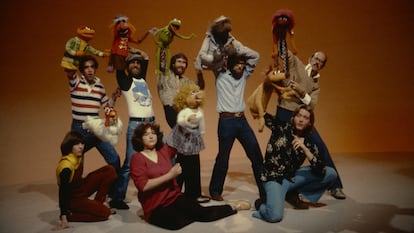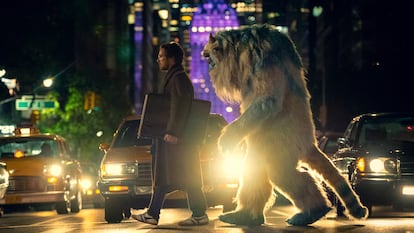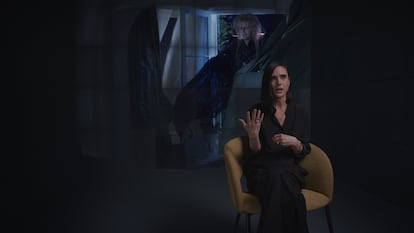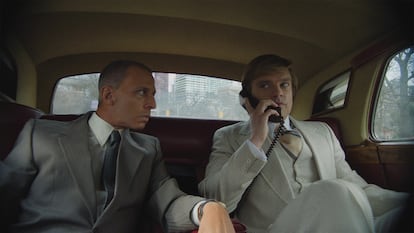Kermit the Frog, ‘Eric’ and other stories from the mean streets of 1980s New York
A documentary on Jim Henson by Ron Howard and the Netflix miniseries starring Benedict Cumberbatch coincide in their portrait of an era as decadent as it was creative

In the 1980s, New York was dangerous and decadent, but it was also a city brimming with energy and ideas: from the most imaginative to the most perverse. In the same mean streets where a genius of entertainment and pedagogy like Jim Henson deployed his latest adventures, there was room for the criminality of the mafias, the underbelly of drugs and the new (and opaque) real estate opportunities, which allowed the self-conscious son of a stern and racist businessman, Donald Trump, to build his megalomaniac empire and everything that would follow. Kermit the Frog, new music — disco, hip-hop, punk, or house music — or the artistic avant-garde of the East Village coexisted in that decade with disaster in a city that was the epicenter of the AIDS epidemic in the United States.
The documentary Jim Henson: Idea Man on Disney+, directed by Ron Howard (Cocoon, Apollo 13), and the miniseries Eric (Netflix), by British playwright and screenwriter Abi Morgan, coincide in reliving that era in a very particular context: the protagonist of Eric, played by a spectacular Benedict Cumberbatch, is a puppeteer and admirer of Henson who lives in Manhattan as his turbulent marital relationship unravels. The street is just as inhospitable as his marriage, but the life of this puppet creator is shattered the day his son disappears, swallowed up by the city’s underworld.

Eric is the name of the puppet the boy dreamed of bringing to life and who is now his father’s rough imaginary friend. Among beggars and junkies, Cumberbatch, the alcoholic son of a real estate tycoon — and an unsympathetic version of James Stewart in Harvey (1950) — will comb the streets alongside a blue stuffed monster that could well have escaped from Fraggle Rock (1983-87), the final television puppet show created by Henson.
In the fourth episode of this interesting and somewhat unbalanced series, the name of Sesame Street’s father comes up when Vincent (Cumberbatch) reproaches his co-worker on the children’s show Good Day, Sunshine! that the day he introduced him to the “god Henson” his ignorance was evident, because he didn’t know who Burr Tillstrom was.
Aggressive, unnerving Vincent was referring to the creator of the TV series Kukla, Fran and Ollie, who met Henson and his wife, Jane, in 1960 at a puppeteers’ convention in Detroit. It was a providential meeting for Henson, as Tillstrom introduced him to his agent and puppet craftsman Don Sahlin. In the 1966 experimental short film The Idea Man, Henson included the Kukla puppet in his limbo of objects and people. The character created by Tillstrom floated next to JFK’s face, a Super 8 camera, a Volkswagen Beetle, a pistol, a Coca-Cola bottle top or the original Kermit, his creator’s alter ego whose body was born from his mother’s old coat and his eyes from a ping-pong ball split in two. Kermit’s face was shaped like a hand, and that allowed Henson to recreate all kinds of emotions.

Howard’s documentary, which inevitably verges on hagiography, includes a significant amount of archival footage and a range of authoritative voices that introduce little-known aspects of a seminal creator. At its beginning, Orson Welles and Henson are seen on a television program in which Welles declares his admiration for a figure who has always proven enigmatic. New York’s Museum of the Moving Image, in the historic Astoria Studios in Queens, dedicates a significant part of its space to this visionary and to the commercials he devised before the revolutionary Sesame Street. Contemplating these short commercial pieces confirms the extent to which Henson transgressed any format. His ad for Bufferin headache pills, narrated by Henson and titled Memories, reveals two of his interests: experimental cinema and LSD.
In the 1980s, Henson — who died from pneumonia in 1990 at the age of 53 — was a puppeteer with the aura of a rock star who did not allow himself to get comfortable. During that decade he continued to push boundaries in his medium through films inspired by his characters and other more somber fantasies, such as The Dark Crystal (1982) or Labyrinth (1986). His New York funeral was at the Cathedral of St. John the Divine, and, as he had wished, no one wore black, the musicians played jazz and the Muppets were in charge of the eulogy.
That procession of furry and colorful dolls fit the chaos of the decade that was ending, the backdrop for Eric but also for at least two films in the upcoming season. Limonov: The Ballad, directed by Kirill Serebrennikov, focuses on the Russian writer’s New York exile at the end of the 1970s, and shares a similar landscape and texture to The Apprentice, Ali Abbasi’s film about Donald Trump’s early business career.
The Apprentice tells the story of the young Trump’s relationship with far-right lawyer Roy Cohn and how Cohn helped him get Trump Tower — built between 1980 and 1984 — off the ground. Nearby and only a year later, at Christmastime in 1985, Paul Castellano, godfather of the powerful Gambino crime family, was gunned down outside a steakhouse. John Gotti, a mobster who strutted around the city flaunting money and power, had struck the blow to reinforce the leadership of his criminal organization, a bloody soap opera that forms the basis of the Netflix documentary Get Gotti, which recreates the sordid panorama of violence and extortion in which New York was immersed in the 1980s. The construction of the city was in the hands of the Mafia and Gotti was the first godfather who understood the new power of fame.

In The Apprentice, the character of Roy Cohn is played by Jeremy Strong and one of his parties sums up the madness of the time: bohemian artists from the Village and young yuppies in orgies organized by an unscrupulous guy who used dirty tricks to knock down the political careers of other homosexuals while he lived a hypocritical double life. Cohn died in 1986 of AIDS, still insisting he had liver cancer.
The sinister lawyer is also one of the main characters in the miniseries Angels in America. Released in 2003, it is Mike Nichols’ adaptation of the famous Broadway play by Tony Kushner (no relation to Jared, Trump’s son-in-law). In it, Al Pacino portrays Cohn and, in one of the final episodes, amid the delirium of his agony, he hears from the mouth of the gay nurse, played by a wonderful Jeffrey Wright, a dark ode to the life and death of big cities: those strange organisms, like dirty New York, that look as though they are “overgrown with weeds, but flowering weeds. On every corner a wrecking crew and something new and crooked going up catty corner to that.”
Sign up for our weekly newsletter to get more English-language news coverage from EL PAÍS USA Edition
Tu suscripción se está usando en otro dispositivo
¿Quieres añadir otro usuario a tu suscripción?
Si continúas leyendo en este dispositivo, no se podrá leer en el otro.
FlechaTu suscripción se está usando en otro dispositivo y solo puedes acceder a EL PAÍS desde un dispositivo a la vez.
Si quieres compartir tu cuenta, cambia tu suscripción a la modalidad Premium, así podrás añadir otro usuario. Cada uno accederá con su propia cuenta de email, lo que os permitirá personalizar vuestra experiencia en EL PAÍS.
¿Tienes una suscripción de empresa? Accede aquí para contratar más cuentas.
En el caso de no saber quién está usando tu cuenta, te recomendamos cambiar tu contraseña aquí.
Si decides continuar compartiendo tu cuenta, este mensaje se mostrará en tu dispositivo y en el de la otra persona que está usando tu cuenta de forma indefinida, afectando a tu experiencia de lectura. Puedes consultar aquí los términos y condiciones de la suscripción digital.
More information
Archived In
Últimas noticias
Most viewed
- Sinaloa Cartel war is taking its toll on Los Chapitos
- Oona Chaplin: ‘I told James Cameron that I was living in a treehouse and starting a permaculture project with a friend’
- Reinhard Genzel, Nobel laureate in physics: ‘One-minute videos will never give you the truth’
- Why the price of coffee has skyrocketed: from Brazilian plantations to specialty coffee houses
- Silver prices are going crazy: This is what’s fueling the rally











































